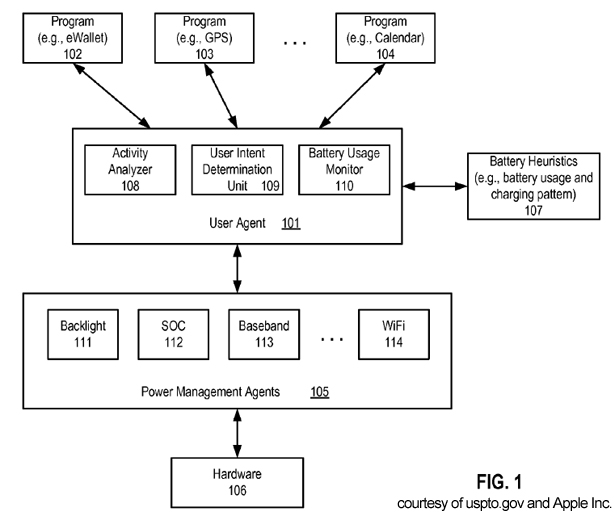A patent application published today by the U.S. Patent and Trademark Office (USPTO) reveals that Apple Inc. (NASDAQ:AAPL) might soon develop a power management system that would sharply increase battery life. Though many of the Cupertino firm’s patents never actually see the light of day in the form of an actual, physical product, the smart power management technique has a wide enough application so that it might be one of the select group that is eventually developed into a real-world project. The process would allow even longer periods of smartphone use between charging.
Patent application 20140082384, titled “Inferring User Intent From Battery Usage Level And Charging Trends,” was originally filed on September 20, 2012, though it was not published by the USPTO until today, exactly 15 months later. The inventors of record are Joshua P. De Cesare and Gaurav Kapoor, while the assignee, predictably enough, is Apple Inc. (AAPL). Mr. De Cesare is an inventor who has filed at least 17 patent applications, 9 of which have been granted at a minimum. Mr. Kapoor is a Stanford-educated computer hardware engineer.

The system described would empower an iPhone to analyze power use and battery charging patterns to create a unique power use profile for the mobile device’s owner. Measuring battery charging and discharging would naturally be the central metric which the “smart” system would use, but other factors would also be measured to increase the predictive effectiveness of the data. These would include the wireless networking stack, the phone’s locale, and readings from the iPhone’s gyroscope and light sensors, among others.
Once it detected consistent patterns of use and idleness in the iPhone, the system would then work out a power saving plan. At times when the Apple (AAPL) communications device’s owner habitually put little to no demand on the system, all power using activities, such as screen brightness, would be automatically dialed back to a minimum level. At other times, when heavy use typically occurred, the system would send a power boost to appropriate areas, such as the processor or the screen.
Overall, this smart, adaptive power budgeting would greatly increase the amount of time a battery charge would last. It would also lessen strain on the physical structure of the battery, making it last longer, too. The Apple Inc. (AAPL) patent application lists at least nine different “embodiments,” or specific ways in which the smart power management could be implemented. In real world terms, having a system like this on an iPhone would mean less time on the charging dock and far fewer occasions when a call became impossible due to an exhausted batter.



